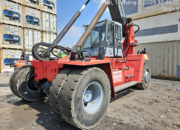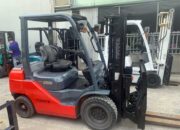How to choose the best forklift
To those who haven’t had any forklift training or haven’t worked much with it, all forklifts look the same. But there is a lot of difference when it comes to the intended use and the accessories. Moreover, not all forklifts meet the same needs, purposes, locations, etc. So, how can you choose the best, most suitable, most useful and efficient forklift for your business? Below, Samcovina.com offers some basic cases and questions you should consider and consider carefully before making a decision to buy a forklift.

- What is the main working environment of the forklift like?
Will you use your forklift indoors or outdoors? Working on gravel, concrete or mud?
If you are planning to find a forklift for indoor and warehouse use only, an electric forklift is a perfect choice. Electric forklifts are designed with low ground clearance, are often fitted with cushioned tires, and are quiet, clean and safe to operate.
If you are looking for a forklift that uses it continuously for outdoor lifting then a diesel forklift would be the best choice in this environment as a diesel engine is not always approved. For use inside a factory, warehouse, yard inside the house.
If you are planning on using your forklift both outdoors and indoors (warehouses, yards, factories, etc.), an LPG/gasoline powered forklift is a better fit for the job.
How to find the right height forklift for your warehouse or yard?
The supplier will only demo show you the lifting capacity of the forklift with any object within a height of 1m. After that, most forklifts will do other tricks. You already have a certain level of storage at a certain height, then you need to measure what is the highest price in your warehouse and add 20 cm.
How to know the forklift load can be lifted?
The lifting capacity for each forklift is different and it depends on the model and make of the vehicle. However, keep in mind that lift is inversely proportional to the height and weight of the load. Loads that are heavier and higher than the lift limit will go slower and lift lower.
Can forklifts be used where there are low doors around?
In the case of low doors, a forklift’s triplex will meet your requirements. With it full of free options, you will be able to work in containers or through lower doors.
What about environments with narrow aisles or tight turns?
Narrow aisles and tight turns require you to choose a forklift that is more compactly designed such as a reach truck or a special one designed specifically for forklift aisles. narrow.
How much does it cost to buy a forklift?
Although the budget for buying this forklift is your top concern and it is probably already calculated and considered by you. But the most important thing is that you choose to buy a forklift that fits your actual needs. So always make sure you carefully consider all aspects, including the technical side, so that you don’t go to waste or end up buying a forklift that doesn’t meet the needs of the job.







